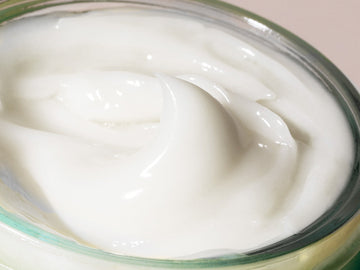
What is Slugging?
Slugging is one of those things in the ever-evolving world of skincare that feels like it both came out of left field and has also been here for all of time. In skincare, new trends and techniques are constantly emerging, with each promising more than the last. How are you supposed to know what is good and what is not? (And transparently… how are you to know what slugging is?)
Despite its rather unusual name (that somewhat sounds like a competitive sport), slugging has become a huge sensation across social media, promoting transformed skin, locked-in moisture, and next-level nourishment. With over 1B posts about slugging on TikTok, millions of people around the world are wondering if they, too, should be doing it. But what is slugging? We’ll lock in the details (which is kinda what slugging is anyway) below.
OK, But Literally, What Is Slugging?
Go where your mind goes first. Slugging gets its name from the fact that it briefly leaves your face looking like a slug. Slugging refers to the shiny, somewhat greasy appearance that you might have on your skin after you “perform the act”—reminiscent of the slimy trail left behind by a slug.
If you’re not freaked out by that reality… here’s what slugging is: Slugging is a technique that involves applying a thick layer of occlusive moisturizer or ointment all over your face as the final step of your skincare routine, typically at night. The goal is to lock in all the moisture and goodness that you’ve created with the rest of your routine for deeper penetration. Many people opt for your classic Vaseline or Aquaphor (aka, petroleum jelly) as the ultimate slug solution.
At its core, slugging is all about creating a solid protective barrier on the skin’s surface to lock in moisture, which sounds great considering skin barrier repair and protection is at the core of the fight against inflammaging. However, even though slugging is the next “shiny” skincare trend making its way through our evening routines, applying occlusive ingredients like mineral oil, lanolin, petroleum, and plant oils on your skin may not be for everyone.
What Is The History of Slugging?
“Back in the day”—like, the 90s—looking “oily” or “dewy” was a beauty no-no, where having a matte-like finish to your face was the gold standard. Nowadays—again, wink-and-nod to social media—looking “peak glowy” is a sign of true vitality and health as far as one’s skin is concerned. Therefore, with everyone feasting after a popped and snatched complexion, along with definitely already having some kind of ointment in their bathroom cabinets, it’s no surprise that slugging has taken off as the ultimate beauty trend.
“But it’s not even a trend!” shout most dermatologists, who have been using occlusive moisturizers to treat skin conditions like eczema, psoriasis, and severe dermatitis foreeevvver. In the medical space, slugging has helped to create a physical seal over wounded or fragile skin to trap moisture, protect the skin, and prevent further damage. Seemingly compelling thus far!
What Are The Main Benefits of Slugging?
So, what exactly are the main benefits of slathering your face with that old tub of jelly? There are some key advantages to this skincare technique. Here are our faves:
→ Intense Hydration
Slugging is particularly beneficial for individuals with dry or dehydrated skin—especially in dryer or colder months when the heat is on full blast 24/7. By forming a protective barrier on the skin's surface, occlusive ointments help trap moisture and prevent it from evaporating, resulting in plump, hydrated skin by the time you wake up.
→ Improved Skin Barrier Function
Considering we’re #SkinBarrierObsessed, we specifically appreciate slugging’s ability to reinforce the skin barrier, which gives it the strength it needs to fight off external irritants while preventing transepidermal water loss. It also improves the skin’s overall pH so as to reduce sensitivity over time.
→ Enhanced Efficacy for Your Skin-Layering Routine
We’ve already chatted about how to best layer your skincare for maximum results, but slugging can totally enhance your routine’s final step. Applying a thin layer of an occlusive product as the last step in your skincare stack can help boost the efficacy of the other products you've applied beforehand. By creating a seal over the skin, slugging ensures that other skincare products like serums, moisturizers, and treatments are absorbed more effectively, maximizing their benefits.
→ Soothing and Calming Effects
For people who are one-steppers vs. multi-steppers in their skincare regimens due to highly sensitive skin, slugging can help skin keep calm and carry on. Because the skin repairs itself while you sleep, having optimal moisture—especially for those with dry or irritated skin types—can significantly benefit the skin barrier and encourage a deeper healing, regenerative process.
→ A Glow Worth Shining For
On the surface, slugging gives that social media filter-level glow—not only because it literally makes your face shine, but because it also helps to lock in moisture, leaving people with a shiny, smooth look—glass skin, if you will...
What To Consider Before Slugging
Like anything in skincare, there is no such thing as a one-slug-fits-all approach. Sure, there are numerous benefits of this very simple technique, but it may not be suitable for everyone. Here are some other things to consider when you’re deciding to slug or not to slug:
→ Clogged Pores
If you have oily skin or acne-prone skin, take a beat before running toward slugging. Depending on the ointment you choose, you might end up with an overly non-comedogenic formula that congests the skin. If you need to slug no matter the risks, consider using an AHA or BHA that helps to slough off dead skin cells or build up and prevent breakouts. You can also opt to use newer slugging products that are geared specifically towards the method with less heavy ingredients vs. your classic OTC jelly.
→ Sensitivity to Other Ingredients
Some people may be sensitive or allergic to certain occlusive ingredients commonly found in slugging products like mineral oil, lanolin, or petrolatum. Patch-testing beforehand is never a bad idea, but you can also look for newer, slugging-specific products that leverage more plant-based, lightweight ingredients.
→ Not Suitable for Daytime Use
We know, we know, looking glowy all day long is the goal. But due to its heavy, greasy texture, slugging is typically reserved for nighttime use when it can optimize skin barrier repair. Applying occlusive moisturizers during the day may feel uncomfortable and interfere with makeup application.
How To Add Slugging To Your Skincare Routine
Can’t stop thinking about slugging? Here are some easy ways to incorporate this next-level hydration technique into your nightly routine:
-
Start with a clean face: Given that slugging can potentially clog pores, you want to make sure you start with cleanser before the layering begins. No makeup, no dirt, no impurities.
- Layer, layer, layer: Complete your typical skincare routine as you normally would, applying any toners, serums, treatments, or moisturizers. We recommend allowing them to fully absorb into the skin before applying your final slug layer.
- Slather the slug: Take a small, pea-sized amount of your slugging moisturizer, and gently massage it into the skin, focusing more heavily on dry-prone areas. Remember: no need to overdo it.
- Let the magic happen: After you’ve essentially “embalmed” your face, go to bed to allow the slugging to work its hydration magic. Something to be aware of: Slugging can be somewhat of a logistical mess, so sleeping on your back or with a towel under your pillow will help avoid a bedding disaster in the long run. Just a thought!
- Wake up looking social media-ready: Make sure to cleanse your face when you wake up—no working out before washing your face or anything of the like. You’ll want to remove any residue so as to avoid buildup and let your skin breathe.
What To Look For In A Slugging Product
Of course, you can call your mom and ask her for that Costco-sized tub of Vaseline she has had since the ‘80s, but there are actually a ton of skincare brands creating slug-efficient products with modern-day skincare ingredients that we cherish. Some to look for:
- Hyaluronic acid → This naturally-occurring, moisture-locking hero is capable of holding up to 1000x its weight in water in our bodies, which keeps our skin bouncy and plump
- Polyglutamic acid → A powerful workhorse skin hydrator that keeps the skin’s pH-balancing bacteria in check. When combined with hyaluronic acid, polyglutamic acid helps to increase the skin’s elasticity and firmness
- Glycerin → A deeply hydrating ingredient that conditions the skin. It helps to moisturize and soften irritated, dry, or cracked skin. It helps to moisturize and soften any dry, cracked, or irritated skin
- Squalane → A skin-loving emollient that coats your skin with moisture that both hydrates and soothes the skin. Squalane can also help to ease irritation
So… To Slug or Not To Slug? That Is the Question.
Just writing about slugging makes us want to try it immediately. But, like anything, proceed with individualized caution before diving face-first into the social media skincare sensation.
If you have any hesitation, start by focusing on improving your skin barrier strength with supportive products that hydrate, soothe, and repair the skin. DEINDE’s skin-strengthening serum and moisture-locking face stick are an iconic duo that combine the antioxidant powerhouse Naringenin (which is 15X more powerful than niacinamide*) with moisture-driven ingredients like Squalane, Ceramides, and Tripeptides. Think of it like Slugging–Light.
*Based on in vitro data quantifying a single biomarker against a single active ingredient
Studies cited:
- Slugging: TikTok TM as a source of a viral "harmless" beauty trend | NCBI
- A comparative histological study on the skin occlusion performance of a cream made of solid lipid nanoparticles and Vaseline | PMC
- Skin occlusive performance: Sustainable alternatives for petrolatum in skincare formulations | NCBI
- Moisturizers: The Slippery Road | PMC









